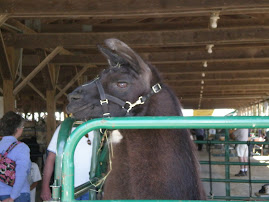Years ago, I took a fantastic weekend spinning class at Halcyon Yarn in Bath, Maine. Among other things, we learned to blend colors on a drum carder. We took fleece that had been dyed primary colors: garish-looking red, blue and yellow, but when blended on the drum-carder, they made lovely heathered blends. I left with a copy of the book Color In Spinning by Deb Menz. Years later, I was traveling up to that neck of the woods, so I stopped by. I bought 3 colors of their Wash Fast Acid Dyes, some Glauber's Salt, Ammonium Sulfate and Synthrapol. A good basic beginner's dye kit, or so I thought. I was planning to blend colors, having bought a red, blue and yellow that looked closest to primary colors of all the jars. They were: Magenta, Bright Blue and Sun Yellow.
I dyed some Cotswald with the magenta, and it turned out more like fuschia or neon pink. One of my favorite colors, so though it was not what it looked like in the jar, I was still happy. The blue, however, came out like an electric blue, which I guess matches the neon pink, but I was not sure what I was going to do with these crazy colors! I tried blending them on the drum carder, and didn't really like the results. I tried blending them in various amounts, but was not happy with the results. I set it aside for awhile. I had nobody to consult on what to do. The internet community for fiber arts we have now did not exist, and I was not near any Fiber Studio or Guild, so I was basically on my own for problem-solving at that time. Plus, I work full-time, and life intervenes frequently in my pursuit of various crafts.
In Summer 2010, for the Tour De Fleece, I wanted to de-stash some of my fiber. I finally got the bright idea of blending on fiber combs. I own some Viking Combs, but I have not used them much, so I had kind of forgotten about them. Sometimes, I can be really dense. Well, that turned out to be the key to it all. You need to use the right tools for the job. Cotswald fleece has very long and silky locks, which should be combed, not carded. The results of some of that can be seen in my post from Tour De Fleece 2010.
However, I had yet to try the Sun Yellow. I had often thought of that while working with the pink and blue fiber, wondering if blending the yellow with electric blue would make a nice green. So this week, I hunted out all my dyeing equipment (the dyepot was finally found after much searching, under a rolled-up Kilim carpet which needs hanging). Luckily, I had made notes from before on what I did, so it was fairly easy to repeat the process. Since I will be blending this yellow with existing, highly-saturated shades, I decided to use the same strength of dye I used last time: 2 tsp. dye powder per 1 lb. of wool.
Yellow is not my favorite color, which is probably why I did it last. I don't wear yellow, for one thing. But it is good for blending. Also, as I was mixing the dye solution and preparing the wool for the dye bath, I thought that yellow is really a good color for Spring. The daffodils are out right now. The dye solution even looked like Easter Egg dye.
Episode 259: Plugging Along
-
*This episode will upload Nov 15, 2025 *
*Comments are welcomed! Either comment here or go to our group on Ravelry.*
Buy Dr Gemma a Ko-Fi, if you're enj...
1 day ago












2 comments:
Dyeing always has seemed so complicated. After reading your post, now I KNOW it is. I applaud what you have done. Will be checking in to see more of your work. Have a great May!
There are lots of variables with dyeing! Concentration is a big one; I have sample cards where I've dyed yarn with different strengths of dye, and you can get really different colors that way. Also, it sounds like you used a mordant (glauber's salt or ammonium sulfate). Acid dyes often don't require them, though you can use them anyway. Mordants can sometimes have dramatic effects on the color, so that /might/ be why they came out different than expected. Personally, I love the yellow in that top photo, and I'm not big on yellow. Used sparingly with a deep blue, green, or eggplant it would be beautiful, especially with all the luster in those locks!
Post a Comment